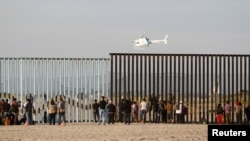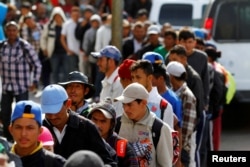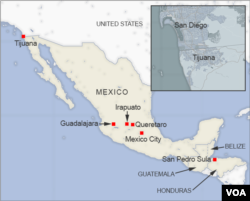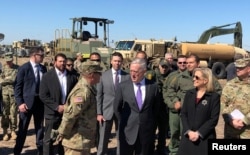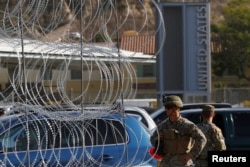Several hundred Central American migrants arrived Wednesday in the Mexican border city of Tijuana after a month of traveling away from poverty and violence at home in hopes of entering the United States.
About 800 migrants are now in Tijuana, and many said they would stay there and wait for the rest of their caravan to arrive and for leaders to advise them on their options for seeking U.S. asylum. Some of the early arrivals went to the border fence to celebrate.
The bulk of the migrant group, about 4,000 people mostly from Honduras, is making its way through the state of Sonora and is expected to arrive in Tijuana in a few days.
100 asylum claims a day
The San Ysidro port linking Tijuana to the U.S. city of San Diego, is the busiest crossing on the border. But it only processes about 100 asylum claims per day, meaning those in the caravan who seek that route face a long wait.
Tijuana could also feel the strain with migrant shelters there already at or near capacity.
The U.S. Customs and Border Protection announced Monday it was closing some vehicle lanes at the San Ysidro crossing and the nearby Otay Mesa crossing in order to install additional security “in preparation for the migrant caravan and the potential safety and security risk that it could cause.” Those measures include barricades, fencing, jersey walls and concertina wire.
U.S. President Donald Trump has sharply criticized the caravans, casting them as a “national emergency.” On Saturday, he signed a proclamation declaring migrants who enter the country illegally ineligible for asylum. That goes against laws that state anyone is eligible for asylum no matter how they entered the country.
The American Civil Liberties Union and other groups quickly filed a legal challenge and sought an injunction against the new rules while the case makes its way through the courts. The government is expected to file a response to the case Thursday, and a federal judge has set a hearing on the injunction for Nov. 19.
Trump has also ordered thousands of troops to the U.S.-Mexico border to support border patrol agents.
Mattis, Nielsen visit
U.S. Defense Secretary Jim Mattis and Homeland Security Secretary Kirstjen Nielsen visited the eastern part of the border Wednesday.
Speaking to reporters en route to McAllen, Texas, Mattis stressed that “border security is part of national security.”
“It’s obviously a moral and ethical mission to support our border patrolmen,” the defense secretary said. “Our units are in a position to enable the border patrol’s law enforcement operations.”
More than 5,600 active duty U.S. troops and another 2,100 National Guard troops have moved to the U.S.-Mexico border area in response to requests for help from the Department of Homeland Security.
The military personnel assigned to help with border security have been helping with barriers, fencing and aerial support. They are legally prohibited from engaging in domestic law enforcement, such as arresting migrants crossing the border.
Mattis told reporters Wednesday the U.S. military has a long history of border deployments. He highlighted 1916, when President Woodrow Wilson deployed troops to stop the threat of Pancho Villa’s troops during the Mexican Revolution, and 1995, when National Guard and several hundred active duty personnel were assigned to assist law enforcement.
Mattis did not mention a deployment in 1997, when an active duty Marine corporal shot a Texas teenager during an anti-drug operation along the Texas-Mexico border, causing the Pentagon to suspend its anti-drug operations there.
In addition to the caravan at or nearing the border, two others have made their way to Mexico City with more than 2,000 people.
Mexico said last week it had issued 2,697 temporary visas to individuals and families allowing them to work while their refugee applications proceed.
VOA Pentagon Correspondent Carla Babb and News writer Chris Hannas contributed to this report.




